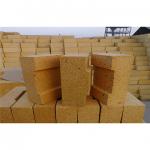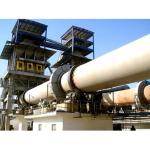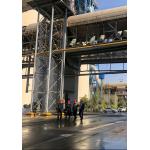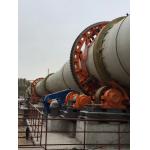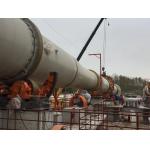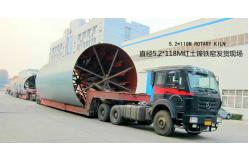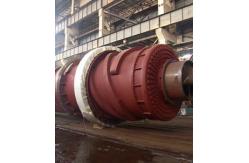Cement Rotary Kiln Laterite Ferronickel Rotary Kiln
Ⅰ. Basic introduction of laterite nickel-iron rotary kiln(Cement
Rotary Kiln)
The company's large-scale laterite-nickel-iron rotary kiln series
products can meet the production line matching of large-scale
laterite-nickel ore smelting nickel projects. The company has the
testing and testing methods of laterite ferronickel rotary kiln and
sophisticated laterite ferronickel rotary kiln manufacturing
equipment and manufacturing technology, forming a complete
technology and production system integrating the design,
manufacture, installation and commissioning services of laterite
ferronickel rotary kiln.
Common specifications and models of laterite nickel-iron rotary
kilns: φ4.4×100m, φ5.2×118m, Φ4.5×110, Φ4.5×110.
Ⅱ. Production process of laterite ferronickel rotary kiln(Cement
Rotary Kiln)
Raw material field - screening, crushing and mixing ingredients -
rotary kiln - submerged arc furnace - iron ladle desulfurization -
refining converter - casting. On this basis, the development of raw
material pre-drying, raw material pelletizing, rotary kiln energy
saving and waste heat power generation, submerged arc furnace
high-efficiency smelting and low melting point slag batching,
bottom blowing or side blowing refining converter instead of top
blowing converter, nickel iron pellets Chemical and other
technologies, suitable for factories with different conditions.
Ⅲ. Process overview of laterite-nickel-iron rotary kiln(Cement
Rotary Kiln)
The ore, limestone and reducing agent are screened and crushed in
the raw material yard and the material preparation room, and then
the mixed ingredients are sent to the rotary kiln.
In the laterite ferronickel rotary kiln, the raw materials are
dried, roasted, and pre-reduced to make ferronickel at about 1000
°C. The flue gas of the rotary kiln is discharged after the waste
heat boiler, dust removal and desulfurization, and the dust is
mixed with the raw materials and then enters the cellar again.
The nickel slag is distributed into the submerged arc furnace
through the feeding pipes at different positions according to the
process requirements in a closed and insulated state. The submerged
arc furnace is fully enclosed.
Ⅳ. Process characteristics of laterite-nickel-iron rotary
kiln(Cement Rotary Kiln)
(1) The raw material has strong adaptability. Most suitable for
high-medium, low-iron nickel oxide ores that are difficult to
process using wet processes.
(2) The nickel-iron grade is high and the harmful elements are few.
The desulfurization and converter refining process of this process
can reduce the harmful elements of ferronickel, which is welcomed
by steelmaking users.
(3) Energy saving and environmental protection, recycling. The raw
material has a lot of moisture, and no dust is generated during the
material yard and screening, crushing and transportation. The waste
heat of the rotary kiln flue gas can be recovered as steam for
power generation. After the flue gas desulfurization meets the
environmental protection requirements, it is discharged into the
atmosphere, and the rotary kiln and submerged arc furnace dust
Return to the material yard; the submerged arc furnace gas is sent
to the rotary kiln as fuel after being dedusted, and the slag
becomes the raw material for the construction industry after water
quenching. The waste heat of the converter flue gas is used to
recover steam, and the gas is recycled. The slag is magnetically
separated and returned to the furnace. The tailings can be used to
pave roads or make cement. From the water-containing charge
entering the rotary kiln to the whole process of iron and slag
tapping in the submerged arc furnace, the charge is fully enclosed,
which is environmentally friendly and energy-saving.
(4) The nickel slag ore is fed into the submerged arc furnace. The
nickel slag produced by the rotary kiln is fed into the furnace at
a high temperature above 900 °C. Compared with the cold material
fed into the furnace, a lot of physical heat and chemical heat are
saved, the consumption of electric energy and reducing agent is
significantly reduced, and the production efficiency is improved.
Cement rotary kiln product parameter
| NO. | Specification (m) | Drawing Number | Basic Parameter | Main Decelerator | Main Motor | Block Type | Support Bearing | Weight
(t) | Remark |
| | | | Rotating Speed (r/min) | Slope (%) | Capacity
(t/d) | Model | Speed Ratio
(i) | Model | Power
(KW) | Rotating Speed (r/min) | | | | |
| 1 | Φ4.5×110 | SBYH206.0 | 0.857~2.57 | 3.5 | 1400 | | | | 2×200 | | Hydraulic | Slide | 903.1 | Dual Drive |
| 2 | Φ4.5×100 | SBYH241.0G | 0.857~2.57 | 3.5 | 1510 | | | | 2×200 | | Hydraulic | Slide | 884 | Dual Drive |
| 3 | Φ4.5×110 | SBYH56.0 | 0.857~2.57 | 4 | 1680 | | | | 2×200 | | Hydraulic | Slide | 912 | Dual Drive |
Cement rotary kiln photo explanation
